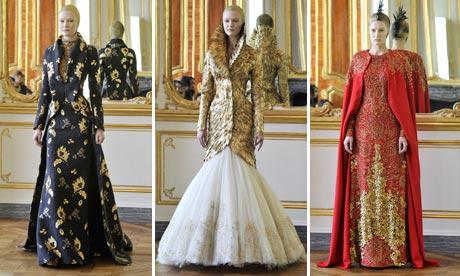
For fifteen minutes today, in a grand Paris drawing room with soaring white ceilings gloriously flounced with gilt, Alexander McQueen came back to life.
When the first model walked into the room, there was an audible intake of breath. Four weeks after the designer's death, the collection he had been working on was finally unveiled. And his spirit was right there — in the skullcap of bandages dissected by a mohican of lacquered feathers, in the fierce black boots with gold angels sculpted into the heels, in the muscular power of the tight crimson bodice and the way the pleated and ruffled skirt appeared to have come not from the past or the future but from some other dimension where the two meet. Every piece was cut on the stand by McQueen, the audience was told beforehand; once the clothes appeared, there could have been no doubt.
Of the outfits, 16 were 80% finished — they were completed by his team and seen for the first time today. The collection was truly spectacular; the mood, in the face of the evidence of what fashion has lost, was bleak.
There is no precedent or protocol for staging a catwalk show which serves also as memorial service. Seven tiny presentations are being held. Altogether, around 70 people will see the clothes. The audience at today's first presentation — a handful of fashion editors and Robert Polet, the boss of Gucci Group — were ushered into a grand parqueted salon.
October 2009's McQueen catwalk show, the last one at which he took a bow, was about the future. It took evolution and the prospect of ecological meltdown as starting points for digitalised reptile-skin prints and freakish "armadillo" shoes subsequently made famous by Lady Gaga. Models were pursued along the catwalk by vast tracked cameras which live-streamed the show on to the internet.
By bittersweet contrast his unfinished last collection, looked to Byzantine art, to eternity and to angels. In folds of double duchesse satin, in a short dress tightly waisted and extravagantly swagged at the hip, could be glimpsed the infant Jesus from Jean Fouquet's 1450 painting of the Virgin and Child, digitally captured and engineered to fit the piece. A pale silk chiffon gown, curves as sculpted as a Greek marble goddess yet so gossamer light it swept the floor in silence, bore the faces of angels and the wings of doves; on the back was the outline of angel wings. In the work of master carver Grinling Gibbons, McQueen found details which he translated into crocodile shoes with gilded wooden heels hand-carved into elaborate columns of twisted ivy festooned with acorns. A red cape, cut away to reveal the flowing, Madonna-esque robe beneath, seemed to echo how, in Botticelli's Cestello Annunciation, Mary is pushing open her virgin-blue cape with her arm to reveal a red dress beneath.
There were chill moments, such as when the Paris sunlight caught the sculpted heel of an ankle boot revealing a carving of a broken skull. The skull had come to be something of a McQueen trademark, but here it appeared crushed. Elsewhere, McQueen's interest in 15th century art seemed to dwell on the Netherlandish solemnity of Hugo van der Goes and the early surrealism of Heironymus Bosch. But there were also Botticelli and Foquet's sweet-faced Madonnas and peachy cherubs. A coat tailored from lacquered gold feathers was probably another nod to Gibbons, whose lifelike carvings of feathered birds have long been much marvelled at. But in the context it could not fail but to call to mind the story of Icarus, who flew too close to the sun.
This was the last ever collection by Lee Alexander McQueen, but it will not be the last collection to bear the Alexander McQueen name. A week after the designer's death, Polet announced that the label would continue. "We believe in the future of the brand," he told reporters. There has been no announcement as to who will replace McQueen. Reports at the weekend that Gucci Group were in discussions with the experimental young British designer Gareth Pugh were flatly denied by both Pugh and Gucci. The in-house design team are working on finishing menswear and diffusion line collections which were under way before McQueen's death.
If there is to be an Alexander McQueen show in October, then a new designer would need to be appointed soon, but a one-season hiatus may well be called for. The fashion industry's gaze rests on Sarah Burton, head of design at the label, who worked closely with McQueen for 16 years since joining at the age of 20. She is now the most senior member of the remaining five-strong design team. Sources at Gucci are adamant that no decision has as yet been made. Until now, all efforts have been directed at finishing this collection. As one of his team said at today's show, "we just wanted to do Lee proud."
A note given to each of the audience read, "each piece is unique, as was he." As the 16th outfit disappeared from the catwalk, the audience sat in silence, not yet ready for the spell to be broken. The sound of clapping began backstage, and spread. There is no doubt McQueen's final collection was a triumph. But there seems little to rejoice in when there is no one to congratulate.





